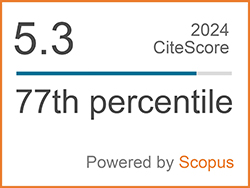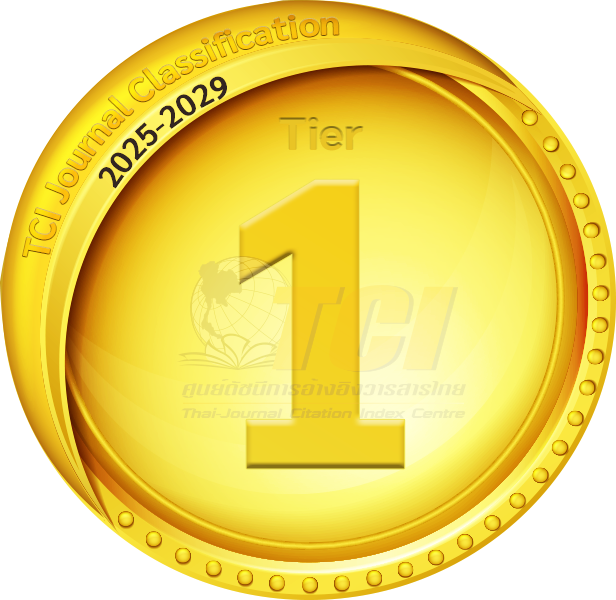CNC Milling and CO2 Laser Engraving of Mixing Microchannels in Microfluidic Devices
Abstract
Keywords
[1] B. Nasseri, S. Akar, and E. Naseri, “Microchannels for microfluidic systems,” in Biomedical Applications of Microfluidic Devices, New York: Academic Press, 2021, doi: 10.1016/b978-0-12-818791-3.00002-4.
[2] I. Muzammil, A. I. Aqib, Q. Tanveer, S. Muzmmal, M. A. Naseer, and M. Tahir, “COVID-19 diagnosis—myths and protocols,” Data Science for COVID-19, vol. 2, pp. 335–353, 2022, doi: 10.1016/b978-0-323-90769-9.00027-x.
[3] L. Capretto, W. Cheng, M. Hill, and X. Zhang, “Micromixing within microfluidic devices,” in Topics in Current Chemistry, 2011, pp. 27–68. doi: 10.1007/128_2011_150.
[4] N. Convery & N. Gadegaard, “30 years of microfluidics,” Micro and Nano Engineering, vol. 2, pp. 76–91, 2019, doi: 10.1016/j.mne. 2019.01.003.
[5] P. B. Kruk and J. A. Wippold, “PRIMDEx: Prototyping rapid innovation of microfluidics devices for experimentation,” SLAS Technology, vol. 33, p. 100326, 2025, doi: 10.1016/j.slast. 2025.100326.
[6] N. Yasman, R. M. R. M. Fouzy, and M. Z. M. Zawawi, “Direct fabrication of glass microfluidic channel using CO2 laser,” Materials Today: Proceedings, vol. 97, pp. 52–60, 2024, doi: 10.1016/j.matpr.2023.11.048.
[7] C. A. Leclerc et al., “Rapid design and prototyping of microfluidic chips via computer numerical control micromilling and anisotropic shrinking of stressed polystyrene sheets,” Microfluidics and Nanofluidics, vol. 25, no. 2, 2021, doi: 10.1007/s10404-020-02414-7.
[8] S. M. Scott and Z. Ali, “Fabrication methods for microfluidic devices: An overview,” Micromachines, vol. 12, no. 3, 2021, doi: 10.3390/mi12030319.
[9] N. Shanehband and S. M. Naghib, “Recent advances in nano/microfluidics-based cell isolation techniques for cancer diagnosis and treatments,” Biochimie, vol. 220, pp. 122–143, 2024, doi: 10.1016/j.biochi.2024.01.001.
[10] T. Zhang et al., “Passive microfluidic devices for cell separation,” Biotechnology Advances, vol. 71, p. 108317, 2024, doi: 10.1016/j.biotechadv. 2024.108317.
[11] P. Cui and S. Wang, “Application of microfluidic chip technology in pharmaceutical analysis: A review,” Journal of Pharmaceutical Analysis, vol. 9, no. 4, pp. 238–247, 2019, doi: 10.1016/ j.jpha.2018.12.001.
[12] A. Saikia, R. Newar, S. Das, A. Singh, D. J. Deuri, and A. Baruah, “Scopes and challenges of microfluidic technology for nanoparticle synthesis, photocatalysis and sensor applications: A comprehensive review,” Chemical Engineering Research and Design, vol. 193, pp. 516–539, 2023, doi: 10.1016/j.cherd.2023.03.049.
[13] K. R. J. Pou, V. Raghavan, and M. Packirisamy, “Microfluidics in smart packaging of foods,” Food Research International, vol. 161, p. 111873, 2022, doi: 10.1016/j.foodres.2022.111873.
[14] D. Yang, M. N. Kashani, and C. Priest, “Pilot-scale microfluidic solvent extraction of high-value metals,” Minerals Engineering, vol. 182, p. 107536, May 2022, doi: 10.1016/j.mineng. 2022.107536.
[15] M. Akbari and A. Seyfoori. “Microfluidic device with integrated magnets for biomarker detection and manipulation.” Espacenet. Accessed: May 13, 2025. [Online.] Available: https://worldwide. espacenet.com/patent/search/family/089770086/publication/US2024042443A1?q=microfluidic%20device%20with%20integrated%20magnets%20for%20biomarker
[16] D. Appleyard et al. “Microfluidic system and method with focused energy apparatus.” Google Patents. Accessed: May 13, 2025. [Online]. Available: https://patentimages.storage.googleapis. com/e5/1c/b0/f912cdbf88927d/AU2023270339A1.pdf
[17] Y. S. Zhang and X. Kuang. “Double networked 3D-printed biomaterials.” Espacenet. Accessed: May 13, 2025. [Online.] Available: https:// worldwide.espacenet.com/patent/search?q=pn%3DEP4561645A2
[18] Z. Akbari, M. A. Raoufi, S. Mirjalali, and B. Aghajanloo, “A review on inertial microfluidic fabrication methods,” Biomicrofluidics, vol. 17, no. 5, 2023, doi: 10.1063/5.0163970.
[19] M. S. Rahim and A. A. Ehsan, “Micro milling process for the rapid prototyping of microfluidic devices,” in Advances in Microfluidics and Nanofluids, S. M. S. Murshed, Ed., London, UK: IntechOpen, 2021, doi: 10.5772/intechopen.96723.
[20] H. van Heeren et al. “Protocols for leakage testing.” White paper. Accessed: May 13, 2025. [Online.] Available: https://chipsproject.eu/wp-content/uploads/2022/07/CHIPS-Protocols-for-leakage-testing.pdf
[21] L. Ding et al., “A modular 3D printed microfluidic system: A potential solution for continuous cell harvesting in large-scale bioprocessing,” Bioresources and Bioprocessing, vol. 9, no. 1, 2022, doi: 10.1186/s40643-022-00550-2.
[22] O. R. Chanu, A. Kapoor, and V. Karthik, “Digital image analysis for microfluidic paper based pH sensor platform,” Materials Today: Proceedings, vol. 40, no. 1, pp. S64–S68, 2021, doi: 10.1016/ j.matpr.2020.03.503.
[23] M. Golozar, W. K. Chu, L. D. Casto, J. McCauley, A. L. Butterworth, and R. A. Mathies, “Fabrication of high-quality glass microfluidic devices for bioanalytical and space flight applications,” MethodsX, vol. 7, p. 101043, 2020, doi: 10.1016/j.mex.2020.101043.
[24] Y. Chen, L. Zhang, and G. Chen, “Fabrication, modification, and application of poly(methyl methacrylate) microfluidic chips,” Electrophoresis, vol. 29, no. 9, pp. 1801–1814, 2008, doi: 10.1002/elps.200700552.
[25] P. Jankowski and P. Garstecki, “Stable hydrophilic surface of polycarbonate,” Sensors and Actuators B Chemical, vol. 226, pp. 151–155, Nov. 2015, doi: 10.1016/j.snb.2015.11.100.
[26] W. Wu, Q. Ouyang, L. He, and Q. Huang, “Optical and thermal properties of polymethyl methacrylate (PMMA) bearing phenyl and adamantyl substituents,” Colloids and Surfaces a Physicochemical and Engineering Aspects, vol. 653, p. 130018, Aug. 2022, doi: 10.1016/ j.colsurfa.2022.130018.
[27] N. Kiomarsipour, A. Eshaghi, M. Ramazani, H. Zabolian, and M. Abbasi-Firouzjah, “Investigation of upward speed and thickness effects on optical and mechanical properties of hard transparent thin films deposited on polycarbonate substrate,” Progress in Organic Coatings, vol. 177, p. 107405, Jan. 2023, doi: 10.1016/j.porgcoat.2023.107405.
[28] S. Kumar, K. Singh, and D. Kumar, “SiO2/B2O3 glass formers effect on transparency and mechanical properties of soda-lime borosilicate glasses for automobile applications,” Journal of Non-Crystalline Solids, vol. 618, p. 122530, Aug. 2023, doi: 10.1016/j.jnoncrysol.2023.122530.
[29] Y. Arcot, G. L. Samuel, and L. Kong, “Manufacturability and surface characterisation of polymeric microfluidic devices for biomedical applications,” The International Journal of Advanced Manufacturing Technology, vol. 121, no. 5–6, pp. 3093–3110, Jun. 2022, doi: 10.1007/s00170-022-09505-5.
[30] H. J. Imran, K. A. Hubeatir, and M. M. Al-Khafaji, “CO2 Laser Micro-Engraving of PMMA complemented by Taguchi and ANOVA methods,” Journal of Physics Conference Series, vol. 1795, no. 1, p. 012062, Mar. 2021, doi: 10.1088/1742-6596/1795/1/012062.
[31] K. Vipindas and J. Mathew, “Machining of borosilicate glass using Micro-End milling,” in All India Manufacturing Technology, Design and Research Conference (AIMTDR), 2019, pp. 189–200, doi: 10.1007/978-981-32-9425-7_16.
[32] Central Drug House (P) Ltd. “Polymethyl methacrylate; CAS No. 9011-14-7.” Cdhfinechemical. Accessed: May 13, 2025. [Online.] Available: https://www.cdhfinechemical. com/images/product/msds/37_1325290147_POLYMETHYLMETHACRYLATECASNO9011-14-7MSDS.pdf
[33] Aladdin Scientific Corporation, “Polycarbonate,” CAS No. 25037-45-0, Feb. 6, 2024.
[34] Sigma-Aldrich, “Borosilicate glass,” CAS No. 308062-88-6,” Aug. 25, 2020.
[35] M. P. Jahan, J. Ma, C. D. Hanson, and G. K. Arbuckle, “Tool wear and resulting surface finish during micro slot milling of polycarbonates using uncoated and coated carbide tools,” Proceedings of the Institution of Mechanical Engineers, Part B: Journal of Engineering Manufacture, vol. 234, no. 1–2, pp. 52–65, Jul. 2019, doi: 10.1177/0954405419862479.
[36] N. Yasman, R. M. R. M. Fouzy, and M. Z. M. Zawawi, “Direct fabrication of glass microfluidic channel using CO2 laser,” Materials Today Proceedings, vol. 97, pp. 52–60, Nov. 2023, doi: 10.1016/j.matpr.2023.11.048.
[37] A. K. Fajrial, A. Vega, G. Shakya, and X. Ding, “A frugal microfluidic pump,” Lab on a Chip, vol. 21, no. 24, pp. 4772–4778, Jan. 2021, doi: 10.1039/d1lc00691f.
[38] M. Krzywinski. “Image Color Summarizer - RGB and HSV Image Statistics.” Bcgsc.ca. Accessed: May 13, 2025. [Online.] Available: https://mk.bcgsc.ca/color-summarizer/?home
[39] Bilican and M. T. Guler, “Assessment of PMMA and polystyrene based microfluidic chips fabricated using CO2 laser machining,” Applied Surface Science, vol. 534, p. 147642, Aug. 2020, doi: 10.1016/j.apsusc.2020.147642.DOI: 10.14416/j.asep.2025.10.001
Refbacks
- There are currently no refbacks.
 Applied Science and Engineering Progress
Applied Science and Engineering Progress







